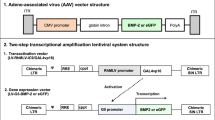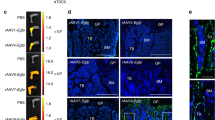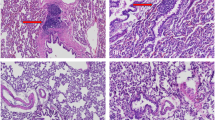Abstract
Bone morphogenetic protein (BMP) adenoviral vectors for the induction of osteogenesis are being developed for the treatment of bone pathology. However, it is still unknown which BMP adenoviral vector has the highest potential to stimulate bone formation in vivo. In this study, the osteogenic activities of recombinant human BMP-2, BMP-4, BMP-6, BMP-7, and BMP-9 adenoviruses were compared in vitro, in athymic nude rats, and in Sprague–Dawley rats. In vitro osteogenic activity was assessed by measuring the alkaline phosphatase activity in C2C12 cells transduced by the various BMP vectors. The alkaline phosphatase activity induced by 2 × 105 PFU/well of BMP viral vector was 4890 × 10−12 U/well for ADCMVBMP-9, 302 × 10−12 U/well for ADCMVBMP-4, 220 × 10−12 U/well for ADCMVBMP-6, 45 × 10−12 U/well for ADCMVBMP-2, and 0.43 × 10−12 U/well for ADCMVBMP-7. The average volume of new bone induced by 107 PFU of BMP vector in athymic nude rats was 0.37±0.03 cm3 for ADCMVBMP-2, 0.89±0.07 cm3 for ADCMVBMP-4, 1.02±0.07 cm3 for ADCMVBMP-6, 0.24±0.05 cm3 for ADCMVBMP-7, and 0.63±0.07 cm3 for ADCMVBMP-9. In immunocompetent Sprague–Dawley rats, no bone formation was demonstrated in the ADCMVBMP-2, ADCMVBMP-4, and ADCMVBMP-7 groups. ADCMVBMP-6 at a viral dose of 108 PFU induced 0.10±0.03 cm3 of new bone, whereas ADCMVBMP-9 at a lower viral dose of 107 PFU induced more bone, with an average volume of 0.29±0.01 cm3.
This is a preview of subscription content, access via your institution
Access options
Subscribe to this journal
Receive 12 print issues and online access
$259.00 per year
only $21.58 per issue
Buy this article
- Purchase on Springer Link
- Instant access to full article PDF
Prices may be subject to local taxes which are calculated during checkout







Similar content being viewed by others
References
Ducy P, Karsenty G . The family of bone morphogenetic proteins. Kidney Int 2000; 57: 2207–2214.
Takae R et al. Immunolocalization of bone morphogenetic protein and its receptors in degeneration of intervertebral disc. Spine 1999; 24: 1397–1401.
Sakou T . Bone morphogenetic proteins: from basic studies to clinical approaches. Bone 1998; 22: 591–603.
Reddi AH . Bone morphogenetic proteins: from basic science to clinical applications. J Bone Joint Surg Am 2001; 83-A: (Suppl 1): S1–S6.
Wozney JM . The potential role of bone morphogenetic proteins in periodontal reconstruction. J Periodontol 1995; 66: 506–510.
Zabka AG et al. Histomorphometric description of allograft bone remodeling and union in a canine segmental femoral defect model: a comparison of rhBMP-2, cancellous bone graft, and absorbable collagen sponge. J Orthop Res 2001; 19: 318–327.
Ripamonti U, Heliotis M, Rueger DC, Sampath TK . Induction of cementogenesis by recombinant human osteogenic protein-1 (hop-1/bmp-7) in the baboon (Papio ursinus). Arch Oral Biol 1996; 41: 121–126.
Viljanen VV, Lindholm TS . Comparison of native xenogeneic and allogeneic bone morphogenetic proteins in the sheep skull defect assay model. Ann Chir Gynaecol 1997; 86: 255–259.
Suh DY et al. Delivery of recombinant human bone morphogenetic protein-2 using a compression-resistant matrix in posterolateral spine fusion in the rabbit and in the non-human primate. Spine 2002; 27: 353–360.
Alden TD et al. In vivo endochondral bone formation using a bone morphogenetic protein 2 adenoviral vector. Hum Gene Ther 1999; 10: 2245–2253.
Helm GA et al. Use of bone morphogenetic protein-9 gene therapy to induce spinal arthrodesis in the rodent. J Neurosurg 2000; 92: 191–196.
Varady P et al. CT and radionuclide study of BMP-2 gene therapy-induced bone formation. Acad Radial 2002; 9: 632–637.
Varady P et al. Morphologic analysis of BMP-9 gene therapy-induced osteogenesis. Hum Gene Ther 2001; 12: 697–710.
Wolfman NM et al. Ectopic induction of tendon and ligament in rats by growth and differentiation factors 5, 6, and 7, members of the TGF-beta gene family. J Clin Invest 1997; 100: 321–330.
Wozney JM . The bone morphogenetic protein family and osteogenesis. Mol Reprod Dev 1992; 32: 160–167.
Krebsbach PH, Gu K, Franceschi RT, Rutherford RB . Gene therapy-directed osteogenesis: BMP-7-transduced human fibroblasts form bone in vivo. Hum Gene Ther 2000; 11: 1201–1210.
Valcourt U et al. Different effects of bone morphogenetic proteins 2, 4, 12, and 13 on the expression of cartilage and bone markers in the MC615 chondrocyte cell line. Exp Cell Res 1999; 251: 264–274.
Turgeman G et al. Systemically administered rhBMP-2 promotes MSC activity and reverses bone and cartilage loss in osteopenic mice. J Cell Biochem 2002; 86: 461–474.
Boden SD . Clinical application of the BMPs. J Bone Joint Surg Am 2001; 83-A: (Suppl 1): S161.
Helm GA, Alden TD, Sheehan JP, Kallmes D . Bone morphogenetic proteins and bone morphogenetic protein gene therapy in neurological surgery: a review. Neurosurgery 2000; 46: 1213–1222.
Groeneveld EH, Burger EH . Bone morphogenetic proteins in human bone regeneration. Eur J Endocrinol 2000; 142: 9–21.
Johnson EE, Urist MR, Finerman GA . Bone morphogenetic protein augmentation grafting of resistant femoral nonunions. A preliminary report. Clin Orthop 1988; 230: 257–265.
Johnson EE, Urist MR . One-stage lengthening of femoral nonunion augmented with human bone morphogenetic protein. Clin Orthop 1998; 347: 105–116.
Mayer H, Scutt AM, Ankenbauer T . Subtle differences in the mitogenic effects of recombinant human bone morphogenetic proteins -2 to -7 on DNA synthesis on primary bone-forming cells and identification of BMP-2/4 receptor. Calcif Tissue Int 1996; 58: 249–255.
Boden SD et al. Differential effects and glucocorticoid potenti-ation of bone morphogenetic protein action during rat osteo-blast differentiation in vitro. Endocrinology 1996; 137: 3401–3407.
Hughes FJ, Collyer J, Stanfield M, Goodman SA . The effects of bone morphogenetic protein-2, -4, and -6 on differentiation of rat osteoblast cells in vitro. Endocrinology 1995; 136: 2671–2677.
Yamaguchi A et al. Effects of BMP-2, BMP-4, and BMP-6 on osteoblastic differentiation of bone marrow-derived stromal cell lines, ST2 and MC3T3-G2/PA6. Biochem Biophys Res Commun 1996; 220: 366–371.
Jane JAJ et al. Ectopic osteogenesis using adenoviral bone morphogenetic protein-4 and -6 gene therapy. Mol Ther 2002; 6: 464–470.
Li JZ, Kao CH, Hankins GR, Helm GA . Preparation of recombinant bone morphogenetic protein gutless adenoviruses. Mol Ther 2001; 3: S50.
Okubo Y et al. The time course study of osteoinduction by bone morphogenetic protein-2 via adenoviral vector. Life Sci 2001; 70: 325–336.
Partridge K et al. Adenoviral BMP-2 gene transfer in mesenchymal stem cells: in vitro and in vivo bone formation on biodegradable polymer scaffolds. Biochem Biophys Res Commun 2002; 292: 144–152.
Franceschi RT, Wang D, Krebsbach PH, Rutherford RB . Gene therapy for bone formation: in vitro and in vivo osteogenic activity of an adenovirus expressing BMP7. J Cell Biochem 2000; 78: 476–486.
Musgrave DS et al. Human skeletal muscle cells in ex vivo gene therapy to deliver bone morphogenetic protein-2. J Bone Joint Surg Br 2002; 84: 120–127.
Gysin R et al. Ex vivo gene therapy with stromal cells transduced with a retroviral vector containing the BMP4 gene completely heals critical size calvarial defect in rats. Gene Therapy 2002; 9: 991–999.
Hazama M, Aono A, Ueno N, Fujisawa Y . Efficient expression of a heterodimer of bone morphogenetic protein subunits using a baculovirus expression system. Biochem Biophys Res Commun 1995; 209: 859–866.
Aono A et al. Potent ectopic bone-inducing activity of bone morphogenetic protein-4/7 heterodimer. Biochem Biophys Res Commun 1995; 210: 670–677.
Musgrave DS et al. Adenovirus-mediated direct gene therapy with bone morphogenetic protein-2 produces bone. Bone 1999; 24: 541–547.
Alden TD et al. Percutaneous spinal fusion using bone morphogenetic protein-2 gene therapy. J Neurosurg 1999; 90: 109–114.
Li JZ et al. In vivo activity of recombinant bone morphogenetic protein 9 gutless adenovirus. Mol Ther 2001; 3: S228.
Tukey JW . Comparing individual means in the analysis of variance. Biometrics 1949; 5: 99.
Yasko AW et al. The healing of segmental bone defects, induced by recombinant human bone morphogenetic protein (rhBMP-2). A radiographic, histological, and biomechanical study in rats. J Bone Joint Surg Am 1992; 74: 659–670.
Cook SD et al. Recombinant human bone morphogenetic protein-7 induces healing in a canine long-bone segmental defect model. Clin Orthop 1994; 301: 302–312.
Baltzer AW et al. Potential role of direct adenoviral gene transfer in enhancing fracture repair. Clin Orthop 2000; 379 Suppl: S120–S125.
Baltzer AW et al. Genetic enhancement of fracture repair: healing of an experimental segmental defect by adeno-viral transfer of the BMP-2 gene. Gene Therapy 2000; 7: 734–739.
Chen S et al. Suppression of tumor necrosis factor-mediated apoptosis by nuclear factor kappaB-independent bone morphogenetic protein/Smad signaling. J Biol Chem 2001; 276: 39259–39263.
Tylzanowski P, Verschueren K, Huylebroeck D, Luyten FP . Smad-interacting protein 1 is a repressor of liver/bone/kidney alkaline phosphatase transcription in bone morphogenetic protein-induced osteogenic differentiation of C2C12 cells. J Biol Chem 2001; 276: 40001–40007.
Bains W, Ponte P, Blau H, Kedes L . Cardiac actin is the major actin gene product in skeletal muscle cell differentiation in vitro. Mol Cell Biol 1984; 4: 1449–1453.
Ebisawa T et al. Characterization of bone morphogenetic protein-6 signaling pathways in osteoblast differentiation. J Cell Sci 1999; 112: 3519–3527.
Rauch C, Brunet AC, Deleule J, Farge E . C2C12 myoblast/osteoblast transdifferentiation steps enhanced by epigenetic inhibition of BMP2 endocytosis. Am J Physiol Cell Physiol 2002; 283: C235–C243.
Cheng JC et al. How does recombinant human bone morphogenetic protein-4 enhance posterior spinal fusion? Spine 2002; 27: 467–474.
Majumdar MK, Wang E, Morris EA . BMP-2 and BMP-9 promotes chondrogenic differentiation of human multipotential mesenchymal cells and overcomes the inhibitory effect of IL-1. J Cell Physiol 2001; 189: 275–284.
Gilboa L et al. Bone morphogenetic protein receptor complexes on the surface of live cells: a new oligomerization mode for serine/threonine kinase receptors. Mol Biol Cell 2000; 11: 1023–1035.
Heldin CH, Miyazono K, ten Dijke P . TGF-beta signalling from cell membrane to nucleus through SMAD proteins. Nature 1997; 390: 465–471.
Fujii M et al. Roles of bone morphogenetic protein type I receptors and Smad proteins in osteoblast and chondroblast differentiation. Mol Biol Cell 1999; 10: 3801–3813.
Aoki H et al. Synergistic effects of different bone morphogenetic protein type I receptors on alkaline phosphatase induction. J Cell Sci 2001; 114: 1483–1489.
Miyazono K, Kusanagi K, Inoue H . Divergence and convergence of TGF-beta/BMP signaling. J Cell Physiol 2001; 187: 265–276.
Yamashita H, Ten Dijke P, Heldin CH, Miyazono K . Bone morphogenetic protein receptors. Bone 1996; 19: 569–574.
Miller AF, Harvey SA, Thies RS, Olson MS . Bone morphogenetic protein-9. An autocrine/paracrine cytokine in the liver. J Biol Chem 2000; 275: 17937–17945.
Song JJ et al. Bone morphogenetic protein-9 binds to liver cells and stimulates proliferation. Endocrinology 1995; 136: 4293–4297.
Yabe T, Samuels I, Schwartz JP . Bone morphogenetic proteins BMP-6 and BMP-7 have differential effects on survival and neurite outgrowth of cerebellar granule cell neurons. J Neurosci Res 2002; 68: 161–168.
Lopez-Coviella I et al. Induction and maintenance of the neuronal cholinergic phenotype in the central nervous system by BMP-9. Science 2000; 289: 313–316.
Alden TD et al. The use of bone morphogenetic protein gene therapy in craniofacial bone repair. J Craniofac Surg 2000; 11: 24–30.
He TC et al. A simplified system for generating recombinant adenoviruses. Proc Natl Acad Sci USA 1998; 95: 2509–2514.
Chroboczek J, Bieber F, Jacrot B . The sequence of the genome of adenovirus type 5 and its comparison with the genome of adenovirus type 2. Virology 1992; 186: 280–285.
Acknowledgements
We wish to thank the Genetics Institute for providing some BMP cDNAs, viral vectors, BMP-9 protein, and antibody. This work was supported in part by grants from Medtronic-Sofamor Danek, Inc. and the National Institutes of Health (Grant No. R01 AR46488-01A2, GAH).
Author information
Authors and Affiliations
Rights and permissions
About this article
Cite this article
Li, J., Li, H., Sasaki, T. et al. Osteogenic potential of five different recombinant human bone morphogenetic protein adenoviral vectors in the rat. Gene Ther 10, 1735–1743 (2003). https://doi.org/10.1038/sj.gt.3302075
Received:
Accepted:
Published:
Issue Date:
DOI: https://doi.org/10.1038/sj.gt.3302075
Keywords
This article is cited by
-
Mesenchymal stem cells overexpressing BMP-9 by CRISPR-Cas9 present high in vitro osteogenic potential and enhance in vivo bone formation
Gene Therapy (2021)
-
Tissue-Engineered Interlocking Scaffold Blocks for the Regeneration of Bone
JOM (2020)
-
Osseous differentiation of human fat tissue grafts: From tissue engineering to tissue differentiation
Scientific Reports (2017)
-
Formulation, Delivery and Stability of Bone Morphogenetic Proteins for Effective Bone Regeneration
Pharmaceutical Research (2017)
-
BMP9 a possible alternative drug for the recently withdrawn BMP7? New perspectives for (re-)implementation by personalized medicine
Archives of Toxicology (2017)



